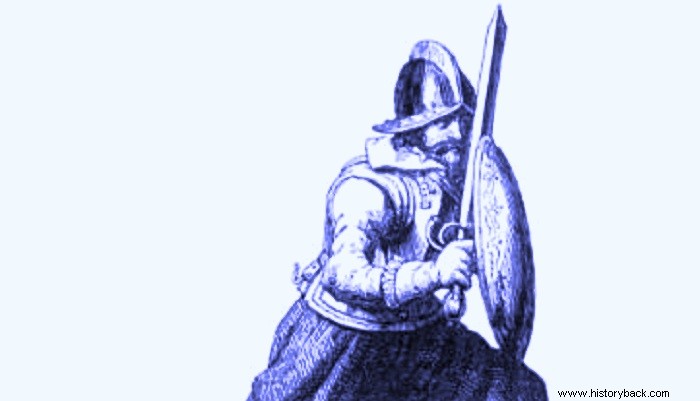
The Rodeleros (=shield bearers) got their name from the small round shield they carried. They were also called "Espantasines", (=swordsmen), as they fought with the sword. These men formed the core of the forces of the infamous Conquistadores, but they also operated in Europe, in all the wars of Spain, in the period from the 15th to the 17th century.
The Ronetleros got their name from the rondela (=round), their small shield, which originally had a diameter of about 20-25cm. but later it grew and its diameter reached up to 60 cm. Their main weapon was the sword, which, depending on the time, was the medieval double-edged infantry sword, with a total length of 90 cm, on average, or later the minute , mainly nightstick, sword, espada ropera type, or rapier type, or the corresponding sword.
Swordsmen appeared in the Spanish armies fighting the Arabs, as a type of light infantry, capable of fighting, however, in groups, on any type of terrain. The men did not, initially, wear armor. Gradually their use became more formal. The initiator of the Colunella formation, the famous Spanish general Gonzalo de Córdoba, having studied military history, came to the conclusion that he needed soldiers similar to the Roman legionnaires, who, in other words, would fight mainly with the sword.
Thus each colonel, with a strength of 1,500 men, had about 650 sarrisos, another as many arquebusiers and 200 or so Rodeleros. Their mission was, when the sarissaphores were engaged in combat with their rival counterparts, to charge in from the flanks and flank and cut down the hooked rival sarissaphores. This tactic was applied, in some way, by the Romans in the battles of Kynos Kefali and Pydna, which were disastrous for the Greeks.
But de Córdoba armed his men heavily, with breastplates, helmets and the largest shield covered with metal leaves. This tactic continued to be applied to the tertio-type formations, which succeeded those of the colonels and which had an organic company of Rodelleros, up to the time of the Thirty Years' War.
In the Italian Wars (1495-1556) the Rodelleros literally wrote history. They were the ones who prevented the defeat of the Spanish Army at the Battle of Ravenna, in 1512. They usually lined up behind the friendly sarissaries and charged at the right moment. Fast and agile, once they got within striking distance, they simply couldn't be countered by the unwieldy rival sarissaphoros.
Many times they were also deployed as a vanguard, but reinforced with divisions of arquebusiers, but also spearmen, as they alone were not able to face the opposing cavalry, due to their armament, but also the open order, in which they fought.
The Ronetleros also formed the core of the small "armies" of the Conquistadores that conquered the New World. In 1520, out of a total of 1,300 that Hernán Cortez had in Mexico, 1,000 were Rodeleros. Even Bernal Diaz, the author of the chronicle of Cortez's conquests, was a Rodeleros who fought under him. In 1521 Cortez fielded 700 Rodeleros and only 118 arquebusiers and crossbowmen.
After the introduction of tertius formations their usefulness was limited, mainly due to the increase in the number and consequently the importance of firearms on the battlefield. The Rodeleros could avoid a sarissa, but not musket fire, anymore. Thus their role was gradually reduced and in the early stages of the Thirty Years' War, they had simply taken over the duties of guarding the flag of the quarter in which they served and then disappeared completely, as a type of soldier.
The Dutch Maurice of Nassau, a great military reformer himself, copying his Spanish rivals, tried to create a similar corps in the Dutch Army, but without much success. Military theorists of the 17th and even 18th centuries proposed the reintroduction of swordsman divisions into European armies, along with the return of the sarissa, on a large scale, as one of the main infantry weapons. Of course none of this happened and the Rodeleros disappeared into the oblivion of time
